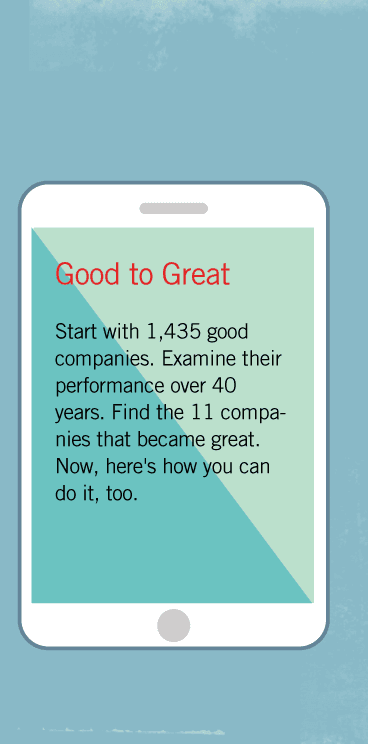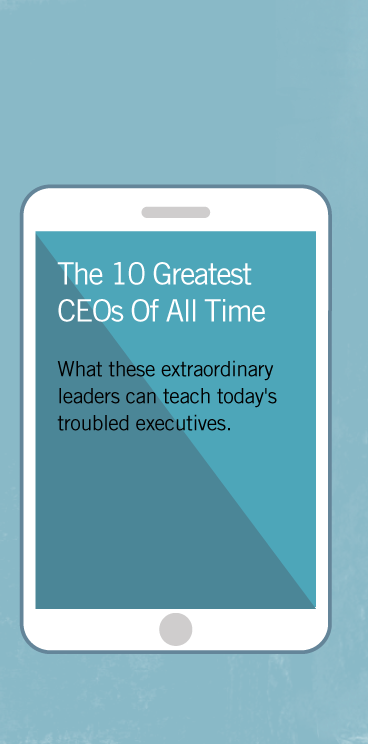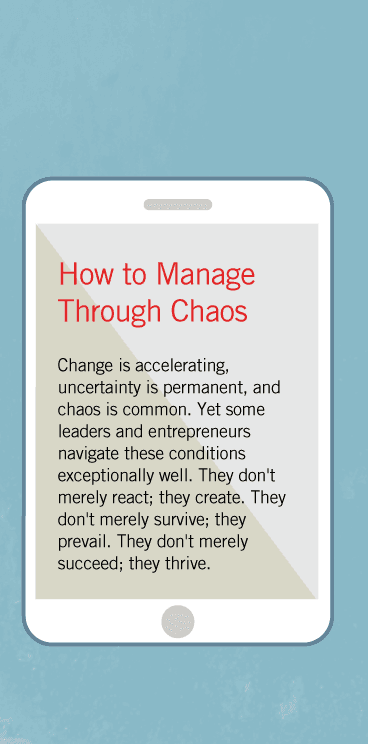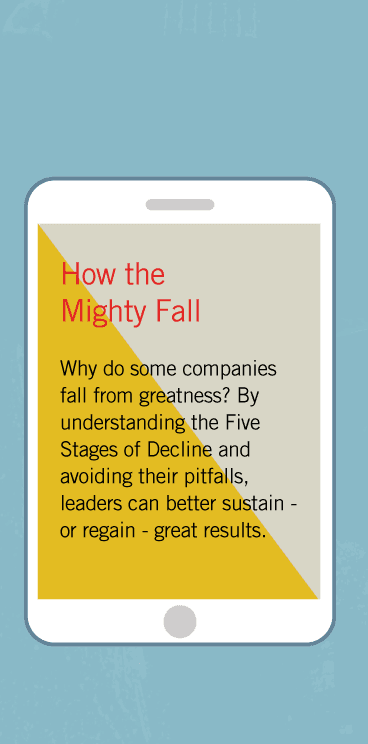The Secret Life of the CEO: Is the Economy Just Built to Flip?
Here's the truth: The problem isn't the market's rise or fall. The problem is people who react to events, rather than seek to create something great.
During the go-go days of the late 1990s, when many business thinkers found themselves seduced by the idea that everything is new in the new economy, Jim Collins marched to a different drummer. Hiding away in "monk mode" at his management laboratory in Boulder, Colorado, he continued his lifelong quest to discover the timeless principles that make enduring great companies.
The former Stanford faculty member takes a data-driven, long-term view of the arc of business. His two best-selling books, Built to Last: Successful Habits of Visionary Companies (HarperBusiness, 1994 ) and Good to Great: Why Some Companies Make the Leap . . . and Others Don't ( HarperBusiness, 2001 ), are both products of years of painstaking research. Collins insists that we need to look at performance over time in order to evaluate a leader's lasting contribution.
In a transcribed conversation, which Collins then edited, Fast Company asked the key questions about CEOs, companies, and our own work lives: How did we get into this mess in the first place? Are all CEOs crooks? What will it take to get business back on track? And what can each of us do to make a difference?
Jim Collins answers below.
The problem: the built-to-flip economy
Sitting in my rocking chair, reading in the New York Times and USA Today about the latest round of corporate scandals, I found myself confronted with a problem: Under what heading should I file all of the articles piling up on my floor? I'm an incorrigible clipper, with cabinets full of articles taken from papers dating back 100 years.
I had problems with my clippings. At first, I filed them under company names: Enron, WorldCom, Qwest. But then there were articles about the widespread abuse of executive compensation, failed acquisitions, deposed CEOs, and dotcom hangovers. Finally, I started labeling most articles under the simple word "Flip"—a file I created after my "Built to Flip" article appeared in the March 2000 issue of Fast Company.
Here's what I realized: All of those stories were connected by one underlying theme: the built-to-flip ethos. I began to see that the dotcom IPO bubble was just one particular strain of a larger pattern, a reflection of a deeper trend in American corporate culture. We didn't just have a built-to-flip IPO bubble; our entire business culture had become a version of built to flip. We became a built-to-flip economy, perhaps even a built-to-flip society.
Consider Enron in this light. I view Enron as the blue-suit, corporate-America version of built to flip. Just like the dotcom excesses, Enron used the capital markets to increase the price of a share—independent of the underlying value of that share — so that a few people could cash out at that inflated price before the markets pounded the price back down to the true value of the share. It's essentially the same idea as starting a dotcom that has minimal current value, taking it public, and cashing out before the game is up—albeit with more nefarious overtones.
The issue here isn't just one of fraud and corruption. The issue is an entire built-to-flip mind-set: opportunists who created a significant delta between short-term share price and long-term share value and then cashed out before the gap could close.
It was popular to speak about the 1990s as the greatest wealth-creation moment in history. In reality, it was just as much a period of wealth transference on a grand scale. One group of people simply transferred wealth to themselves at the expense of another group of people. A whole generation saw it as a once-in-a-lifetime opportunity to get in, get theirs, and get out before the bubble burst. They saw it not just as an opportunity, but also as an entitlement. And we are paying the price today.
The driver: a disproportionate number of conscious opportunists
A confluence of historical events made all of this possible. We had a 20-year bull market that moved huge amounts of capital into retirement accounts. Multiply that change by the baby boom, and you've got two big variables compounding each other. Now add in the vastly increased use of equity and stock options, and it all adds up to a bull-market bubble—and a huge opportunity. But businesspeople responded to that opportunity in four different ways.
At one end of the continuum were the self-directed people. For them, none of this was important. They just went about the daily tasks of building a successful enterprise: trying to build sustainability, create innovations that make a contribution, and add value. They were out there in places like Minnetonka, Minnesota, quietly going about their work. These were also the people who, when confronted with an environment that asked them to breach their values, refused to participate (akin to those who refused to shock the "learner" with intense electrical jolts in the famous Stanley Milgram experiments, despite the fact that 65% of the test subjects did so).
A bit further along the continuum, we encounter the malleable masses. These were the people who, in the presence of an opportunity to behave differently, got drawn into it, one step after another. If you told them 10 years ahead of time, "Hey, let's cook the books and all get rich," they would never go along with it. But that's rarely how most people get drawn into activities that they later regret. When you are at step A, it feels inconceivable to jump all the way to step Z, if step Z involves something that is a total breach of your values. But if you go from step A to step B, then step B to step C, then step C to step D ... then someday, you wake up and discover that you are at step Y, and the move to step Z comes about that much easier.
Social psychologists call this process "commitment and consistency." In Milton Mayer's essay, "They Thought They Were Free," he explains the process this way: A farmer never notices the corn growing minute by minute. But if he stays in the field long enough, he wakes up one day to discover that it has grown over his head. The people who make up the malleable masses weren't bad at the outset. But through a series of gradual steps, they ended up in bad situations—in over their heads.
The third category consists of the conscious opportunists. An ex-student of mine told me, "I knew it was a momentary gold rush that would someday come to an end and that I had one chance to get in and out before the whole thing crashed." But here's the litmus test: If it weren't for all of the spectacular opportunity, how many people would have been drawn into doing what they were doing? It might be accurate to call something a "once-in-a-lifetime opportunity," but that does not make it a reason to participate. Creative, passionate people who invent work of real value will have many once-in-a-lifetime opportunities.
At the far end of the continuum were the architects of evil. Just as there are heroic leaders who elevate others to a higher level, there are also evil leaders who take people into darkness. They understand the power of A to B, B to C, C to D, and Y to Z, and they use that psychological mechanism to create situations where otherwise-good people participate in awful things. Those people are frequently charismatic characters whom people want to believe. And that only serves to make them more dangerous.
The group that grew disproportionately in the 1990s was not the architects of evil, but rather the conscious opportunists. The architects of evil have always existed in our economic system, and—given the right circumstances—they will emerge again. We cannot legislate them out of the system; we can only throw them in jail when they emerge. (And they should certainly go to jail for an amount of time that is proportionate to the scale of their damage to society.) But we shouldn't design our economic system in lurching reaction to the architects of evil.
One change that would certainly help would be to index stock options to the market and to prohibit stock options from being cashed out for at least 10 years after they are issued. That one change would get many of the problem executives off the bus — the flippers would choose to leave, the builders would stay—and help alleviate the destructive confusion between the concepts of share price and share value. It would also help eliminate the destructive sense of entitlement that infected our economic system: Too many people got the idea that they "deserved" entrepreneurial rewards without taking entrepreneurial risks.
The way out: creators vs. reactors
Here's the essential truth of our current situation: The real problem has stayed the same, regardless of the direction of the market. First we went through a spiraling-up phase, and people lost their bearings as they got caught up in the great melee of opportunity. Now we're in a downward spiral, and people have lost their bearings in a scramble of uncertainty. It's the exact same pattern in reverse: people merely reacting to circumstances, rather than doing anything fundamentally creative.
The distinction isn't between a market that's going up and a market that's going down. It's between people who are fundamentally creators and people who are only reactors, who take their cues from the outside world.
If you did a word search across my research materials on the greatest company builders of the past 100 years, you would find almost no mention of "competitive strategy." Not that those builders had no strategy; they clearly did. But they did not craft their strategies principally in reaction to the competitive landscape or in response to external conditions and shocks. Without question, they kept a wary eye on the brutal facts.The fundamental drive to transform and build their companies was internal and creative. It didn't matter whether they faced a crisis (as did Thomas J. Watson Sr. at IBM, who never resorted to layoffs in the Great Depression) or whether they faced calm (as did Walt Disney when he conceived of Disneyland). The leaders who built enduring great companies showed a creative inside-out approach rather than a reactive outside-in approach. In contrast, the mediocre company leaders displayed a pattern of lurching and thrashing, running about in frantic reaction to threats and opportunities.
If I could bring all of my students back into the classroom, I would remind them of David Packard's admonition that in the long run, "more companies die of indigestion than starvation." If a company focuses on making creative contributions that fall in the middle of three intersecting circles—what it is passionate about, what it can be the best in the world at, and what best drives a sustained profitable economic engine—then growth will likely follow.
The research that went into my books showed that mediocre companies tend to focus on growth for growth's sake, whereas truly great companies focus on making creative, profitable contributions that are squarely focused on those three circles. Regardless of whether the market is up or down, great companies that adhere to those circles are, in the long run, likely to have more growth than they can handle—indigestion, not starvation. The same holds true for creative people who discover what they are passionate about, what they are genetically encoded for, and how they can build an economic engine based on their contributions. Those who operate at the intersection of all three circles are more likely to face the problem of too much opportunity in their lives, not too little.
|
The Important Distinction |
|
|
Creator
|
Reactor
|
The question: Which side are you on?
Abraham Maslow defined self-actualization as the process of discovering what you were made to do and making a commitment to do it with excellence. That is what the three circles are all about: making self-actualization work in a capitalist society. No one ever reached self-actualization simply by seizing a bubble moment to get rich and retire. Similarly, no one ever self-actualized by taking the cockroach strategy of just hunkering down and trying to survive until difficult times passed.
There are, of course, no guarantees. Luck is always a factor, and the dice can roll against you. But that does not change the fact that those who go about their lives and work with the passion to create and build in pursuit of self-created goals are the only ones who will find meaning in the end—regardless of whether the dice roll their way. The fact of the matter is that life is short, and we only carry to our graves the inner integrity of our efforts. Only we know how we lived our lives, whether we cut corners, whether we did anything of value—or whether we took the built-to-flip approach to life.






